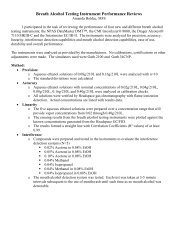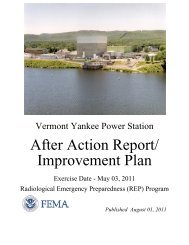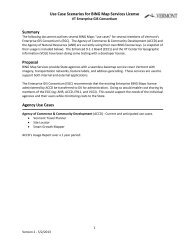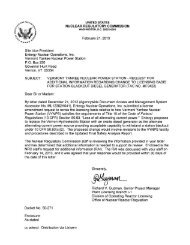3-1-2013 Letter from VY to NRC Plan for Reliable ... - State of Vermont
3-1-2013 Letter from VY to NRC Plan for Reliable ... - State of Vermont
3-1-2013 Letter from VY to NRC Plan for Reliable ... - State of Vermont
- No tags were found...
Create successful ePaper yourself
Turn your PDF publications into a flip-book with our unique Google optimized e-Paper software.
AREVA NP Inc.ANP-3203Revision 0<strong>Vermont</strong> Yankee Nuclear Power Stations Overall Integrated <strong>Plan</strong> in Response <strong>to</strong> March 12, 2012Commission Order Modifying Licenses with Regard <strong>to</strong> Requirements <strong>for</strong> <strong>Reliable</strong> HardenedContainment Vents (Order Number EA-12-O5O)Response (ref. ISG Item 1 2.7):Page 20The detailed design <strong>for</strong> the HCVS will address condensation accumulation resulting <strong>from</strong>intermittent venting. In situations where <strong>to</strong>tal elimination <strong>of</strong> condensation is not feasible, theHCVS will be designed <strong>to</strong> accommodate condensation, including allowance <strong>for</strong> applicable waterhammer loads.The HCVS Containment Isolation Valves will be tested in accordance with the licensing anddesign basis <strong>for</strong> the plant. The HCVS past the outboard Containment Isolation Valve <strong>to</strong> wherethe vent exits the plant Reac<strong>to</strong>r Building will be tested in con<strong>for</strong>mance <strong>to</strong> one <strong>of</strong> the ISGmethods. The test pressure shall be based on the HCVS design pressure with 56 psig.Permissible leakage rates <strong>for</strong> the interfacing valves will be within the requirements <strong>of</strong> AmericanSociety <strong>of</strong> Mechanical Engineers Operation and Maintenance <strong>of</strong> Nuclear Power <strong>Plan</strong>ts Code(ASME OM) — 2009 Subsection ISTC — 3630 (e) (2> or later edition <strong>of</strong> the ASME CM CodeWhen testing the HCVS volume, the allowed leakage will not exceed the sum <strong>of</strong> the interfacingvalve leakages as determined <strong>from</strong> the ASME OM Code unless a higher leakage acceptancevalue is justified <strong>to</strong> the <strong>NRC</strong>.The test types and frequencies will con<strong>for</strong>m <strong>to</strong> the ISG 1.2.7 Table “Testing and InspectionRequirements” with the clarification that “Leak test the HCVS” applies <strong>to</strong> the HCVS boundaryvalves.Requirement 1.2.8 - Design PressuresThe HCVS shall be designed <strong>for</strong> pressures that are consistent with maximum containment design pressures,as well as, dynamic loading resulting <strong>from</strong> system actuation.ISG 1.2.8 Criteria:The vent system shall be designed <strong>for</strong> the higher <strong>of</strong> the primai’y containment design pressure or PCPL. anda saturation temperature corresponding <strong>to</strong> the HCVS design pressure. However if the venting location is<strong>from</strong> the diywell, an additional margin <strong>of</strong> 50 “F shall be added <strong>to</strong> the design temperature because <strong>of</strong> thepotential <strong>for</strong> superheated conditions in the drywelt The piping, valves, and the valve actua<strong>to</strong>rs shall bedesigned <strong>to</strong> withstand the dynamic loading resulting <strong>from</strong> the actuation <strong>of</strong> the system, including pipingreaction loads <strong>from</strong> valve opening, concurrent hydrodynamic loads <strong>from</strong> SRV discharges <strong>to</strong> the suppressionpool, and potential <strong>for</strong> water hammer <strong>from</strong> accumulation <strong>of</strong> steam condensation during multiple ventingcycles.Response (ref. ISG Item 1.2.8):The HCVS design pressure is 62 psig and design temperature is 281°F. The HCVS designpressure is the higher <strong>of</strong> the containment design pressure and the PCPL value. The detaileddesign will ensure a HCVS design temperature <strong>of</strong> 309°F, corresponding <strong>to</strong> a design pressure <strong>of</strong>62 psig under saturated conditions.The piping, valves, and valve actua<strong>to</strong>rs will be designed <strong>to</strong> withstand the dynamic loadingresulting <strong>from</strong> the actuation <strong>of</strong> the HCVS, including piping reaction loads <strong>from</strong> valve opening,concurrent hydrodynamic loads <strong>from</strong> SRV discharges <strong>to</strong> the suppression pool, and potential <strong>for</strong>water hammer <strong>from</strong> accumulation <strong>of</strong> condensation during multiple venting cycles.






